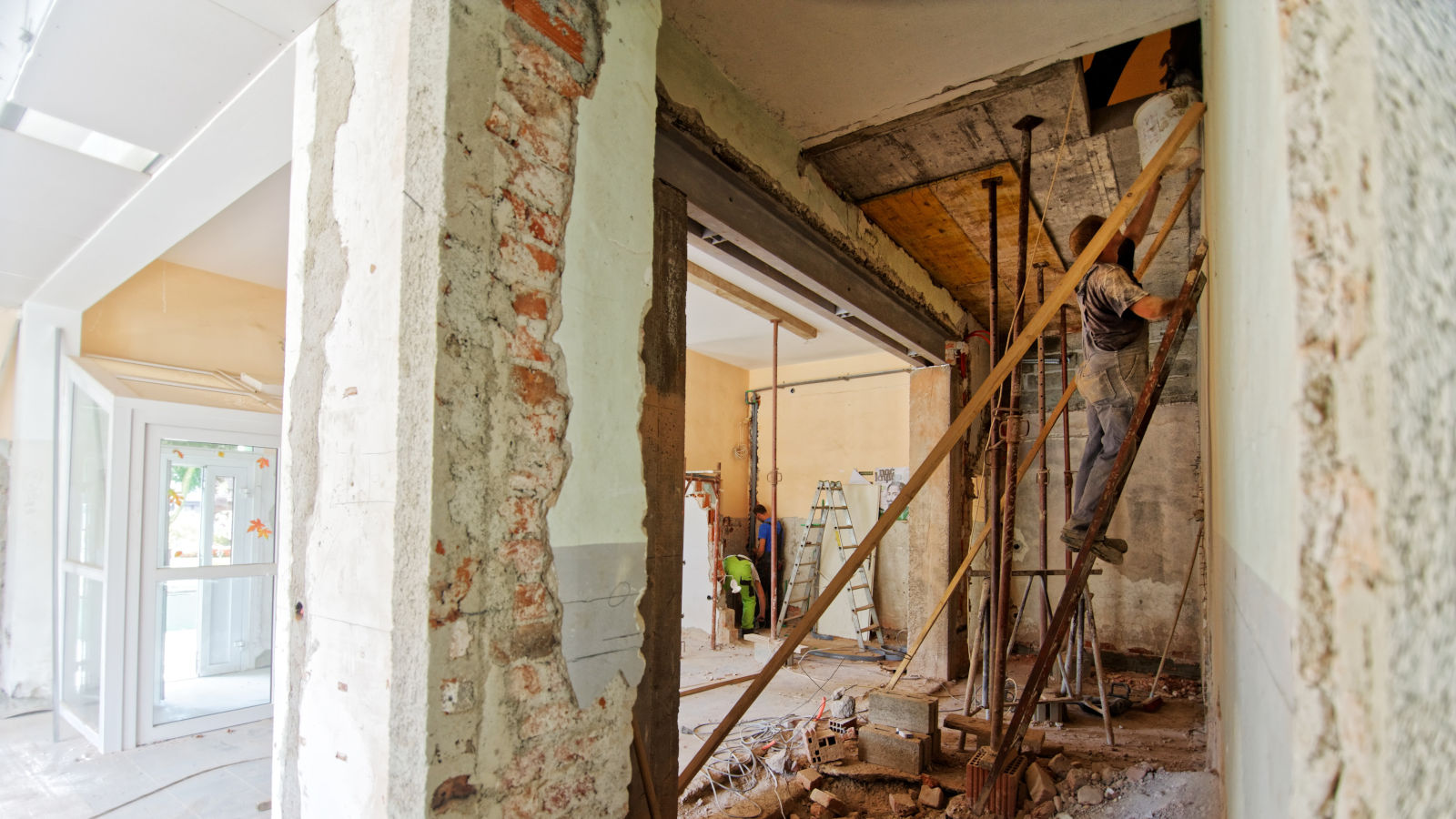
It is more than strange that there is only little reliable data available on the renovation market in Germany given the large market volume. Around 185 billion euros (excluding taxes) are currently flowing into this segment. A gigantic market not only for finishing trade companies, but above all for the supply industry. Data problems are one issue, future bottlenecks in this area another. The sector must get along with considerably fewer craftsmen especially in the long-run.
The renovation market – the unknown being
In contrast to public perception, the majority of construction work in Germany is not aimed at new buildings and structures, but at the maintenance and modernisation of existing ones. This applies, in particular, to the building construction sector, in which almost two thirds are accounted for measures on existing buildings and only one third for construction of new residential and non-residential buildings.
Thus, as far as the use of labour or the production of building materials is concerned, music clearly plays in the renovation sector. However, this segment is fundamentally more difficult to grasp, since unlike in new construction, units such as buildings, surfaces or volumes cannot simply be counted. In fact, there is little available information on this area. At best, reliable data exists on the construction output of finishing trade companies who focus on repairs, refurbishments and conversions of buildings, although they are also involved in new construction projects at the same time.
Therefore, the following procedure is used to estimate the renovation volume: First, the scope of the entire building construction output is calculated, including associated additional costs such as for planning or official fees (this is due to European statistical guidelines). After this, the value for the statistically very well recorded new construction sector is then determined. In a third step, the volume of new construction is subtracted from the value of the total building construction output which results in the size of the renovation market. Further subdivisions of the renovation segment are difficult due to a lack of further information.
Nevertheless, surveys and special evaluations (cf. DIW Berlin and Heinze GmbH) show the development of energetic measures (building construction 2017: 30% energetic, 70% non-energetic) or about the market structure according to project scope (14% maintenance, 71% partial renovation, 15% full modernisation) since the recent past. However, we hardly know anything about the distribution of the output volumes among subgroups of the energetic renovation (façade/roof insulation, windows), on retrofitting or replacement work with regard to the heating of buildings or on age-appropriate renovations (bath, elevator).
Restrained outlook for both building renovation sectors
From 2006 onwards, significantly more funds were invested in the renovation of buildings (cf. Figure 1). This was mainly due to the economic recovery after many years of stagnation and growing unemployment. Against this backdrop, numerous owners again dared to make more extensive investments. At the same time, however, construction demand was driven by exorbitantly high energy prices. This also included building-based solar power projects, which were generously subsidized.
The financial crisis and the recession that followed in 2009 were not able to permanently stifle demand for renovation works. Renovation volumes in both building construction segments reached new highs in 2011. Thereafter, however, the owners of non-residential buildings held back strongly especially on modernisation projects. Since 2013, the market has only developed sideways. Many companies have apparently done their “homework” so far or do not see enough reasons to justify major investments. On the one hand, this may have to do with creeping migration of energy-intensive industries abroad, but on the other hand it may also have to do with regional developments – e.g. when looking at regions with shrinking population. In addition, despite the significantly improved financial situation, municipalities have great difficulties with finding contractors for (energetic) renovation of administrative buildings, schools or sports facilities. And there is evidence of a very high need for investment here. Due to a regular survey among municipalities (cf. KfW-Kommunalpanel) the total investment backlog in 2018 amounted to 43 billion euros for education, to 14 billion euros for public administration, to 9 billion euros for sports facilities and pools and to 8 billion euros for childcare. The majority of this need should account for renovation measures.
The preservation of the housing stock (2018: 131 billion euros, excluding taxes) requires considerably higher expenditure than the upkeep of non-residential buildings (54 billion euros). After all, this is about the maintenance and modernisation of currently estimated more than 43½ million dwellings. It can be assumed that a substantial investment backlog had built up by 2006. In the years 2006 to 2008, however, housing renovation measures greatly expanded, namely from 105 billion euros in 2005 to 125 billion euros in 2008 (in 2018 prices). The average annual refurbishment volume for the whole period 2006 to 2018 amounted to over 125 billion euros. This means that in the past 13 years additional 20 billion euros have been invested in the housing stock each year compared to 2005. And because of the already applied price-adjustment, the additional expenditure due to price increases (estimated at least 40% since 2005, around 4½% for the year 2018) is not even included yet. It can therefore be assumed that in the meantime the need for renovation has been substantially reduced due to the strong expansion of financial means being invested.
With regard to the changes in the individual subgroups, speculation is the only option. Thus, the work on external wall insulation or window replacement may have lost importance in the past, whereas presumably more measures were carried out in the area of age-appropriate reconstruction, as well as, of building extension including adding additional floors. For example, the increase in the renovation volume from 2016 onwards can be linked to the significantly higher number of permits for residential units in existing residential buildings.
The outlook for the future must not be too optimistic. This is because in the past one and a half decades the “low-hanging fruits” should have been harvested in particular. Nowadays, on the other hand, it is more important to provide incentives for those owners whose properties offer only manageable incentives for modernisation (e.g. because of low energy-saving potential at low energy prices, little equity capital, unclear use horizon of the property, complex ownership structure, insufficient rental income in shrinking regions, increasing reluctance in case of permanently tightened rent regulation). It will therefore be more a question of maintaining the exorbitantly high level currently achieved at all, rather than increasing it substantially. In 2018, more money was spent on the renovation of the German housing stock than on the entire construction activity (residential/non-residential/civil engineering) in Ireland, Portugal, Sweden, Slovakia, the Czech Republic and Hungary combined.
Growing shortage of craftsmen
Even if policymakers, under the pressure of their own climate constraints, significantly increase the requirements placed on existing buildings, the question of implementation remains unresolved. Most of the measures still require the use of craftsmen who already show a very high utilisation. But today their work can only be relieved to a limited extent by means of serial prefabrication, digital means or other technical progress.
In fact, the number of employees within the German construction industry has developed quite differently since 2010 (cf. Figure 2). For example, the main construction industry, which, above all, carries out shell construction work, recruits employees quite continuously with a growing pace in recent years – most of them with foreign passports. In contrast, the finishing trade, which concentrates heavily on the renovation of buildings, has hardly increased its number of employees since 2012. Since 2013, the main construction industry has on balance recruited three times as many workers than the finishing trade companies. On the one hand, finishing trade companies, which usually consist of only a handful of employees, have fewer good contacts abroad and typically hardly any personnel resources to act in this field. On the other hand, there is often no interest in significantly increasing the number of employees. At the same time, the number of apprentices has fallen dramatically in the finishing trade since the mid-1990s, even though there has been a slight increase recently.
ABOUT THE AUTHOR
Ludwig Dorffmeister
ifo Institute
Ludwig Dorffmeister, industry specialist at the Munich-based ifo Institute, has been monitoring the construction sector in Germany for about one and a half decades now. For the market analysis, he can, among others, draw on a large number of in-house survey results.
Germany also faces immense challenges in the light of ageing population. About half of the construction workers are expected to retire over the next 20 years, this is due to estimations of the Social Fund of the Construction Industry (SOKA-BAU). And a large number of self-employed craftsmen and/or company owners of finishing trade companies will be withdrawing, with handover to a successor becoming increasingly difficult. Most other European countries are facing a similar fate so that labour migration cannot be a major solution. But also in the distant future the building stock in Germany wants to be well maintained. Unfortunately, we do not yet know how this can be achieved.
ABOUT THE AUTHOR
Ludwig Dorffmeister
ifo Institute
Ludwig Dorffmeister, industry specialist at the Munich-based ifo Institute, has been monitoring the construction sector in Germany for about one and a half decades now. For the market analysis, he can, among others, draw on a large number of in-house survey results.
